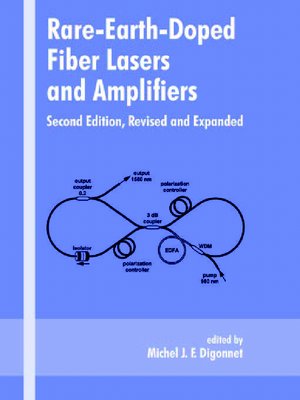Rare Earth Doped Fiber Lasers and Amplifiers, Second Edition, Revised and Expanded
ebook ∣ Optical Engineering Series, Book 71
By Michel J. F. Digonnet

Sign up to save your library
With an OverDrive account, you can save your favorite libraries for at-a-glance information about availability. Find out more about OverDrive accounts.
Find this title in Libby, the library reading app by OverDrive.



Search for a digital library with this title
Title found at these libraries:
| Library Name | Distance |
|---|---|
| Loading... |
Presented in an easy-to-use, comprehensive reference, Rare-Earth-Doped Fiber Lasers and Amplifiers, Second Edition discusses the essential principles, operating characteristics, and current technology of the main fiber laser and amplifier devices based on rare-earth-doped silica and fluorozirconate fibers.
Describes in detail the principles, designs, and properties of the erbium-doped fiber amplifier (EDFA) and its role as the cornerstone component in optical communication systems!
Covering all aspects of this revolutionary technology, Rare-Earth-Doped Fiber Lasers and Amplifiers, Second Edition
- reviews fiber fabrication methods and the basic spectroscopic properties of rare-earth ions in glasses
- concentrates on the most important fiber laser sources such as neodymium (Nd)- and erbium (Er)-doped fiber lasers operated as continuous wave, Q-switched, and mode-locked sources
- examines several advances in fiber amplifiers, in particular the erbium-doped (1.5 µm), thulium-doped (1.4 and 1.65 µm), and praseodymium-doped (1.3 µm) amplifiers, in both silica- and fluoride-based hosts
- analyzes new findings and improvements in single-frequency operation, frequency tunability, broadband fiber sources, and blue-green and far-infrared fiber lasers
and more!
Illustrated with nearly 700 drawings, photographs, equations, and tables, and over 1200 up-dated literature references, Rare-Earth-Doped Fiber Lasers and Amplifiers, Second Edition makes a necessary and ideal addition to the resources of optical, electrical, electro-optical engineers; optical, laser, and applied physicists; and upper-level undergraduate and graduate students in these disciplines.







